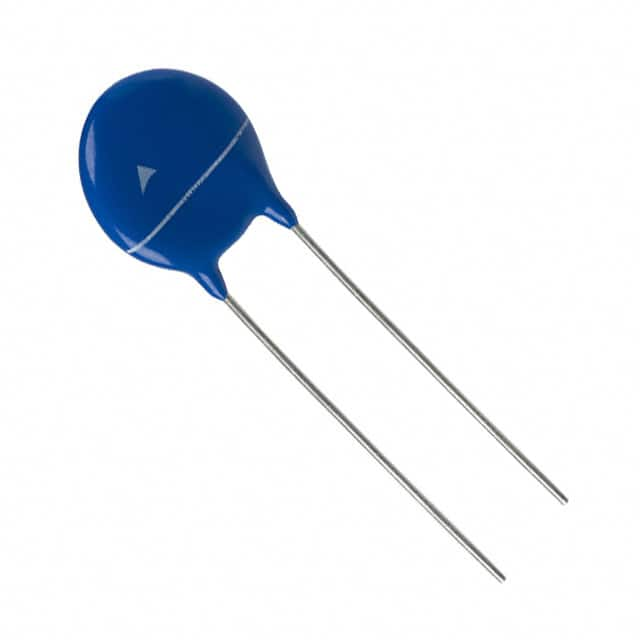B72214S0301K501
Product Overview
Category
The B72214S0301K501 belongs to the category of varistors, which are electronic components used to protect circuits from overvoltage conditions.
Use
This varistor is commonly used in electronic circuits to suppress voltage spikes and transient surges, thereby safeguarding sensitive components from damage.
Characteristics
- High energy absorption capacity
- Fast response time
- Wide operating temperature range
- Low leakage current
Package
The B72214S0301K501 varistor is typically available in a disc-shaped package with lead wires for easy integration into circuit boards.
Essence
The essence of this varistor lies in its ability to rapidly dissipate excess energy during voltage surges, thereby protecting connected devices.
Packaging/Quantity
These varistors are usually packaged in reels or trays, with quantities varying based on manufacturer specifications.
Specifications
- Model: B72214S0301K501
- Voltage Rating: 300V
- Nominal Discharge Current: 5kA
- Maximum Energy Absorption: 110J
- Operating Temperature Range: -40°C to 85°C
Detailed Pin Configuration
The B72214S0301K501 varistor typically features two lead wires for connection to the circuit. The pin configuration may vary based on the specific manufacturer's design.
Functional Features
- Voltage clamping during transient events
- Rapid dissipation of surge energy
- Reliable protection against overvoltage conditions
Advantages
- Effective protection of sensitive electronic components
- Wide operating temperature range
- High energy absorption capacity
Disadvantages
- Limited lifespan after repeated exposure to high-energy transients
- Susceptibility to thermal runaway under extreme conditions
Working Principles
The B72214S0301K501 varistor operates based on the principle of nonlinear resistance, where its resistance decreases as the applied voltage increases. This allows it to divert excessive current away from the protected circuit, thereby limiting the voltage across the load.
Detailed Application Field Plans
Power Supplies
In power supply units, the B72214S0301K501 varistor can be employed to protect against voltage spikes caused by lightning strikes or switching transients.
Industrial Equipment
Industrial machinery and equipment can benefit from the use of these varistors to safeguard control circuits from electrical disturbances.
Consumer Electronics
Devices such as televisions, computers, and home appliances can be equipped with B72214S0301K501 varistors to ensure reliable protection against power surges.
Detailed and Complete Alternative Models
- B72214S0301K101
- B72214S0301K301
- B72214S0301K701
This comprehensive entry provides an in-depth understanding of the B72214S0301K501 varistor, covering its basic information, specifications, functional features, advantages, disadvantages, working principles, application field plans, and alternative models.
قم بإدراج 10 أسئلة وإجابات شائعة تتعلق بتطبيق B72214S0301K501 في الحلول التقنية
What is the B72214S0301K501 component used for in technical solutions?
- The B72214S0301K501 is a varistor, commonly used for overvoltage protection in electronic circuits.
What are the key specifications of the B72214S0301K501?
- The B72214S0301K501 has a maximum AC voltage of 250V, a maximum DC voltage of 320V, and a nominal varistor voltage of 275V.
How does the B72214S0301K501 protect electronic circuits from overvoltage?
- When an overvoltage occurs, the varistor conducts current and diverts the excess voltage away from the protected circuit, thereby preventing damage.
What are the typical applications of the B72214S0301K501 in technical solutions?
- The B72214S0301K501 is commonly used in power supplies, industrial equipment, telecommunications devices, and consumer electronics to protect against transient voltage spikes.
What is the operating temperature range of the B72214S0301K501?
- The B72214S0301K501 has an operating temperature range of -40°C to +85°C, making it suitable for a wide range of environments.
Can the B72214S0301K501 be used in automotive applications?
- Yes, the B72214S0301K501 is suitable for automotive electronics and can provide overvoltage protection in vehicles.
Is the B72214S0301K501 lead-free and RoHS compliant?
- Yes, the B72214S0301K501 is lead-free and complies with the Restriction of Hazardous Substances (RoHS) directive.
What is the response time of the B72214S0301K501 during overvoltage events?
- The response time of the B72214S0301K501 is very fast, typically in nanoseconds, providing rapid protection to the connected circuitry.
Does the B72214S0301K501 require any additional external components for proper operation?
- No, the B72214S0301K501 is a standalone varistor and does not require additional external components for its basic overvoltage protection function.
Are there any recommended mounting or soldering guidelines for the B72214S0301K501?
- Yes, the manufacturer provides specific guidelines for mounting and soldering the B72214S0301K501 to ensure reliable performance in technical solutions.


